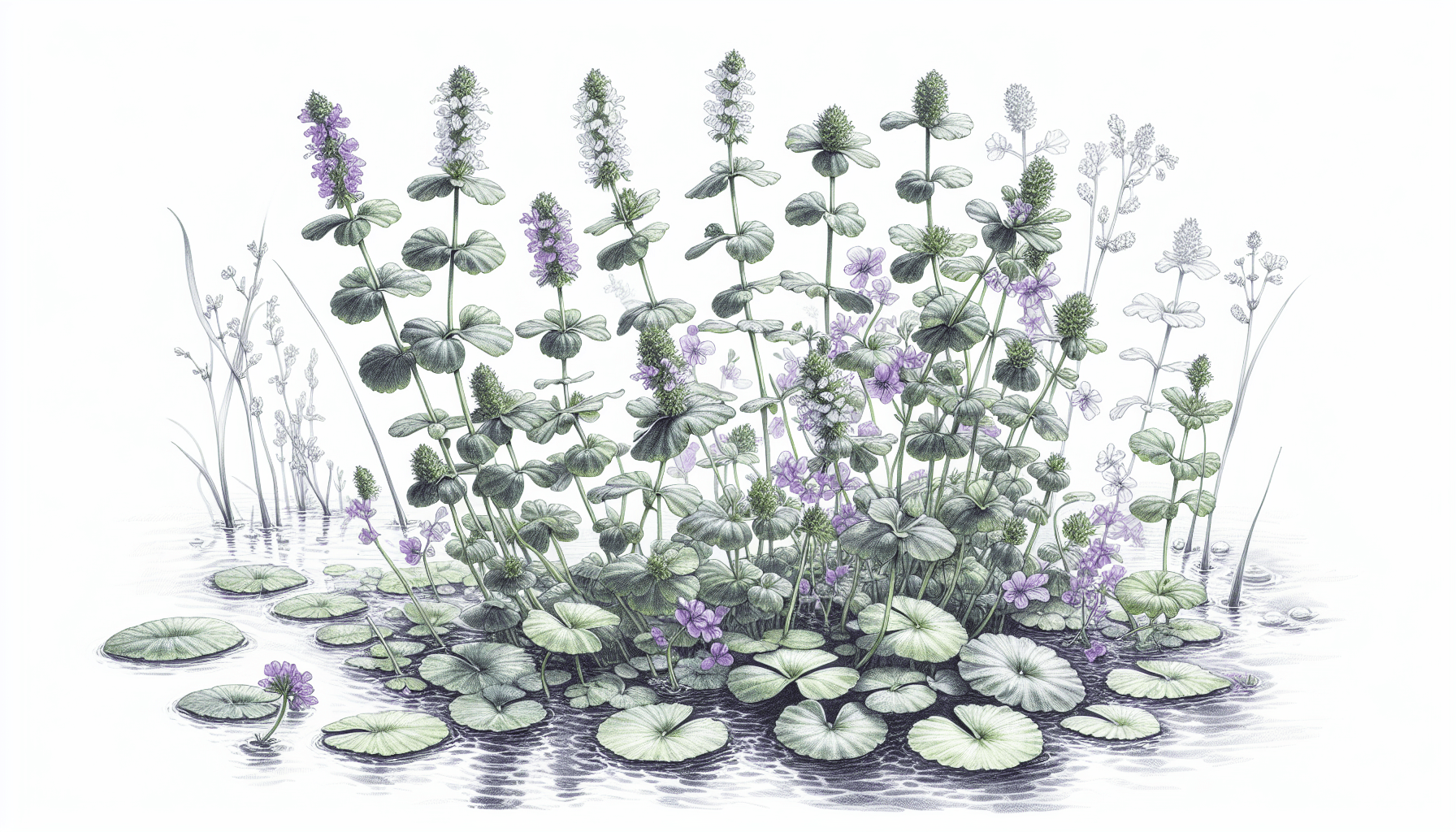In your exploration of aquatic ecology, you may encounter a unique species of aquatic weed known as Hyptis Alata. This vegetation, which prospers in water-ridden regions, carries a novel set of characteristics that differentiates it from its terrestrial counterparts. This article is designed to offer you a succinct, yet comprehensive understanding of Hyptis Alata, expounding upon its morphology, habitat, propagation, and environmental impact, thereby enhancing your knowledge about aquatic plant species and their role in maintaining the health and diversity of our planet’s large and complex water bodies.

Defining Aquatic Weeds
Aquatic weeds, by definition, include a diverse array of plants that have adapted to live in water or in wet soil conditions. These plants may be divided into four general classes. The first is submerged weeds, which typically grow beneath the water’s surface. The second category is referred to as floating weeds. As the name suggests, these plants float on the water surface, with roots that may or may not penetrate the substrate. The third, emergent weeds, are rooted in the substrate but extend above the water level. The fourth, including plants known as marginal weeds, dwells at the water’s edge, requiring saturated soil but not necessarily standing water.
Classification of aquatic weeds
The classification of aquatic weeds can be quite complex, considering the great diversity comprising hundreds of different species. Some of the most common aquatic weeds are Water Hyacinths, Hydrilla, Duckweed, and Eurasian Watermilfoil. They are typically classified based on their growth form and habitat preference, but can also be categorized by their life cycle, such as annual, biennial, or perennial.
Importance of aquatic weeds in aquatic ecosystems
Despite being categorized as ‘weeds,’ many aquatic plant species play a crucial role in their ecosystems. They provide food and habitat for numerous organisms, contribute to nutrient cycling, improve water quality by absorbing pollutants, stabilize sediments, and can enhance the aesthetic appeal of water bodies. However, when growth gets out of control, negative impacts often occur, such as reducing biodiversity, altering water chemistry, or blocking water pathways, which leads us to the necessity of aquatic weed management.
Introduction to Hyptis Alata
Hyptis alata, also known as Cluster Bushmint, is an example of an aquatic weed that can be both beneficial and detrimental to the environment.
Scientific classification of Hyptis Alata
Hyptis alata belongs to the Lamiaceae family, also known as the mint family. The genus Hyptis comprises about 400 species. Hyptis alata is a species with wide distribution and several common names.
Common names for Hyptis Alata
Depending on the region, Hyptis alata has numerous common names such as ‘Cluster Bushmint’, ‘Muskgrass’, ‘Bushmint’, or ‘Musk Basil’. The different names often reflect the physical characteristics or habits of the species.
Origin and distribution of Hyptis Alata
Hyptis alata is native to tropical and subtropical regions across the Americas. Its range stretches from the southern United States through Central America to South America.
Physical Description of Hyptis Alata
General plant structure
Hyptis alata features a bushy, erect growth habit with stems that can reach up to around 1 meter in height. The stems are heavily branched, producing an overall clump or cluster form, hence the ‘Cluster Bushmint’ common name.
Description of leaves
The leaves of Hyptis alata are relatively large, being oblong to lance-shaped, and feature a smooth, glossy surface. Each leaf margin is substantially serrated, and both sides often feature short, fine hairs that impart a subtly aromatic fragrance when crushed.
Description of flowers and seeds
The flowers of a mature Hyptis alata plant are small, tubular, and predominantly white in color, featuring purple lines or spots. The seeds are tiny and dark brown, contained within small nutlets, which release when the plant is disturbed.
Growth habits and reproduction methods
This species has an annual life cycle but might behave like a perennial in warmer climates. It reproduces from both seeds and stem fragments, which can aid the plant’s dispersal by water or human activity.

Habitat and Growth Conditions for Hyptis Alata
Preferred type of water bodies
Hyptis alata shows a preference for marshes, the margins of ponds and lakes, and occasionally, slow-moving rivers and streams. It can tolerate disturbance and readily colonizes areas with fluctuating water levels.
Climate and temperature requirements
While Hyptis alata thrives in tropical and subtropical climates, it also displays a degree of cold tolerance, capable of surviving brief periods of frost. It prefers full sun exposure but can tolerate light shade.
Soil and nutrient needs
Hyptis alata is notably adaptable in terms of substrate conditions. It can grow in a wide range of soil types, whether sandy, loamy, or clayey. It has a high tolerance for nutrient-rich and poorly drained soils, thriving in either acidic or alkaline soils.
Role of Hyptis Alata in the Ecosystem
Role in water quality improvement
Like many aquatic plants, Hyptis alata has a role in improving water quality. It can absorb a range of pollutants, thus reducing their concentrations in the water.
Relationship with aquatic life
Hyptis alata serves as a vital habitat and food source for a range of organisms. Its dense growth provides cover and breeding sites for various aquatic species.
Role in the food chain
Hyptis alata is an integral part of the food chain in many aquatic environments, being consumed by various invertebrates, fish, and water birds, which in turn are prey to larger carnivorous species.
Benefits of Hyptis Alata
Benefits to the ecosystem
Hyptis alata contributes positively to biodiversity, enhancing habitat complexity, which supports a broad range of organisms.
Economic benefits
The plant’s extracts have been used in traditional medicine, and scientific research has confirmed its potential therapeutic properties.
Use in traditional medicine
Traditionally, Hyptis alata has been used to treat various ailments like fever, inflammatory diseases, respiratory conditions, and digestive disorders.
Negative Impacts of Hyptis Alata
Impact on water flow
When left unchecked, Hyptis alata can form dense stands that impede water flow, leading to flooding and localized changes in water chemistry.
Effects on the native species
Excessive growth of Hyptis alata can potentially outcompete native plant species, reducing biodiversity and overall ecosystem health.
Economic consequences
Management expenses of controlling Hyptis alata infestations and the associated damage can significantly contribute to economic losses.
Management and Control of Hyptis Alata
Mechanical control methods
Mechanical methods, such as hand pulling, mowing, or physical removal, are often effective for smaller infestations of Hyptis alata.
Chemical control methods
For larger infestations, chemical control methods may be necessary. Different herbicides that target broadleaf plants can successfully manage Hyptis alata, but care must be taken to avoid collateral damage to non-target organisms.
Biological control methods
Biological control methods, including the introduction of specific insect species that feed on Hyptis alata, are currently being researched and could provide a promising, environmentally-friendly alternative to chemical control.
Research Studies on Hyptis Alata
Phytochemical investigations
Phytochemical investigations have revealed that Hyptis alata contains various compounds, including essential oils and antioxidants, relevant to potential pharmaceutical applications.
Toxicological studies
Toxicological studies have shown that extracts from Hyptis alata can have antimicrobial and antifungal effects, suggesting potential roles in combating infections and preserving food.
Studies on uses in traditional medicine
As an integral part of traditional medicine, Hyptis alata’s therapeutic applications have been confirmed by scientific research, including its use as an anti-inflammatory, analgesic, and antipyretic agent, along with potential anticancer properties.
Future Perspectives on Hyptis Alata
Potential for commercialization
With its plethora of potential medicinal uses and phytochemical properties, Hyptis alata is ripe for commercial exploration, whether in the pharmaceutical, cosmetic, or nutraceutical industries.
Potential risks and challenges
On the other hand, its invasive nature presents challenges for its commercial cultivation, and further research is necessary to minimize any potential negative impact on biodiversity and ecosystem health.
Areas for further research
Several aspects of Hyptis alata’s biology and ecology warrant further investigation, such as understanding its invasive mechanisms, exploring more sustainable management strategies, and researching its unknown phytochemical compounds and their potential applications.